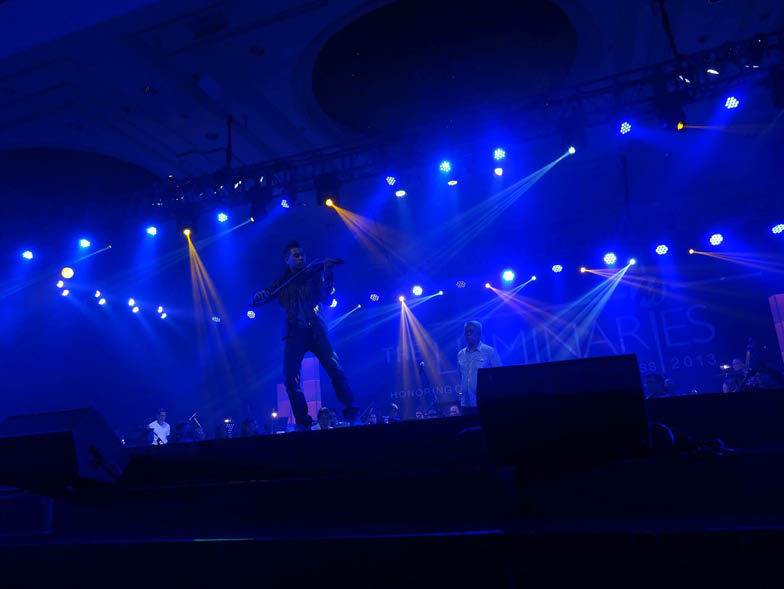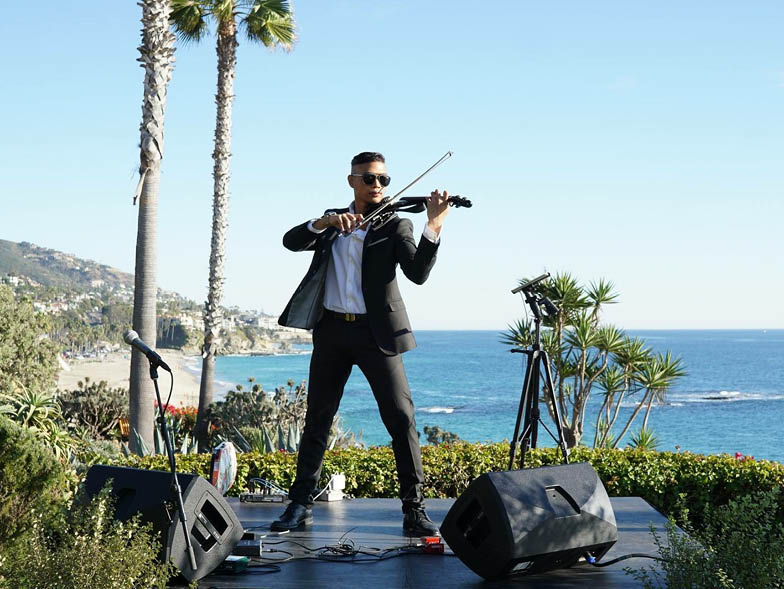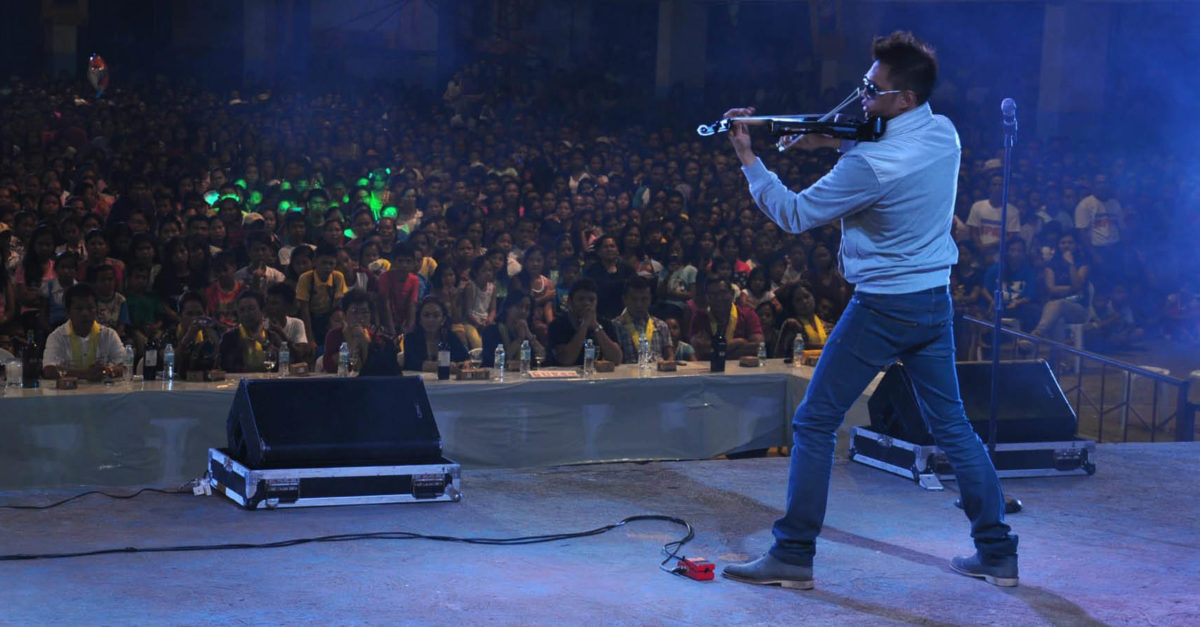A Violinist Gone Viral
With a growing YouTube following, Bryson Andres has made a name for himself as a violinist for the digital age. His ability to evolve as a musician—paired with his ear for turning something mainstream into a sound all its own—is worthy of the viral views, and then some.
How did you get started with music?
My interest in music began when I was younger. I wanted to feel closer to my father, who I had yet to meet but had watched sing on old VHS tapes. In my eyes, he was a rock star. The summer before I started sixth grade, I finally met him and was excited about taking up the drums in the school band. But I had a crush on a girl who was in the orchestra, so I changed my mind at the last minute and joined that instead. Before classes started, I mentioned to my dad that I was joining the orchestra and, without hesitation, he said, “Anything you want, I got it, son.” He then purchased a violin and sent it to me in Alaska. This began my journey into the music world.

What was your upbringing in Alaska like, and how did that influence you as a musician?
I had the typical ’90s-kid lifestyle, mixed with some fishing and camping on the Kenai River, which maybe isn’t so typical. No one in my family was as into music as I was, so I saw violin as something that would be my “thing.” It became my obsession—I used songs on the radio to practice ear training and notation, and I would practice finger patterns on any and all surfaces. Many people wouldn’t expect this, but Alaska has a really strong string community, and the level of musicality is top-notch. There are a lot of passionate teachers who offer guidance. When I was younger, I didn’t appreciate that as much and just wanted to make music freely. As I progressed, I started purchasing books with my lunch money and sat next to the advanced kids in orchestra to study their techniques and sound. I worked my way up to become section leader in the Anchorage Youth Symphony.
How did learning violin in the orchestra eventually lead to covering popular songs on YouTube?
Pop songs came very naturally to me. I enjoyed learning songs by ear that were both fun and challenging, especially when “Twinkle, Twinkle, Little Star” wasn’t exactly cutting it for me anymore. I started performing at family events, obliging requests just so I would continue getting better. Studying pop songs in tandem with the required school material eventually led to some musical experiments. I would record multiple takes over each other (a technique known as looping), and this gave birth to something completely unique. In retrospect, all of this did wonders for my musical arrangement skills. I didn’t fully transition into pop until after high school, when I no longer had symphonic duties.
What made you want to upload your first video?
I was getting some hate from kids at school for playing violin, so I turned to the internet in the hope that I would find a more encouraging audience. Soon after uploading my first video, I deleted it because people online started doing the same thing that kids at school were doing. It took some serious self-reflection to get over the opinions of others. My family supported and encouraged me, which made me rethink the situation and start uploading again.

What was the defining moment for you—the one that made you want to pursue this passion full time?
When I was twenty years old and hoping to find success, I was approached by a man who described himself as a big-time producer. In the end, I was scammed out of $3,000 on the way to Los Angeles—on top of my equipment and clothes being stolen—and then told by TV executives in California that my music style wasn’t marketable. Even at the lowest point in my life, I knew music was my passion and the only thing I wanted to do. Shortly after that, I was captured playing violin on the streets of Spokane, Washington, by a stranger, and my career began to skyrocket.
You’ve built a strong following over the years. Is there pressure involved with having an audience?
In the beginning, I was more focused on having fun and performing in as many local places as possible. I didn’t really know anything about the entertainment industry, so becoming “discovered” opened my eyes to a lot. As my career started to grow, so did my insecurities. I quickly realized what I was wearing and how I looked wasn’t up to the industry standards. It blew my mind that even things like hair and makeup had to be a certain way. I became super self-conscious about losing my hair at such a young age, so I just buzzed it off when I was twenty-five. But, with time, the pressure in all facets of the music world pushed me to be the best version of myself for my supporters and management team.

What is your process for covering a popular song and morphing it into something unique?
When choosing a song, I try to go with a melody, beat, or message that sticks with me. Then I listen to it repeatedly in the shower, when working out, and while driving, and I even set it as my alarm clock. I’m listening for those key sounds that make it unique. It takes me about ten to fifteen minutes to learn the melody and capture the artist’s styling. Then I move on to basic chord structure, supporting lines, moving lines, ornamentation, and drum patterns. I arrange and rearrange the song into parts before refining it to the final product. It sounds like a lot, but it only takes about two hours.
How many hours a day do you typically practice?
I practice for two hours a day, which includes warming up, freestyling, and refining a song I’m currently working on. Sometimes I’ll practice into the night without even realizing it.
What is your favorite cover so far?
Every cover I’ve done has been my favorite because I only play songs that I love. One that’s requested often from my followers is “Secrets” by OneRepublic.
How did you overcome doubt in such a competitive industry?
I don’t think anyone in this industry can say they’ve completely outgrown that dreadful feeling. But some deep self-reflection led me to conclude that the reason I ever doubted myself was because I was comparing myself to others. I’ve learned to be genuinely happy for others. Everyone’s journey through life, especially with music, is a personal one.

What musicians have been especially inspiring to you?
I’ve been a fan of Imogen Heap since I was fourteen—her performance of “Just for Now” inspired my style of looping. Lucia Micarelli is another big one for me—she’s a violinist with a delicacy to her style but also an intensity that I’ve always loved.
What has been your favorite performance so far, and why?
I performed in Asia for the first time in 2012 and learned and experienced so much about what the music industry has to offer. I felt as if I had finally found my people. It was also my first big gig, so I was excited and nervous but also cautious. I didn’t want a repeat of my experiences in California. The game changer for me was going from spare changing on the streets to performing among other worldwide acts on an international platform—it was an opportunity to immerse myself in the business, and it helped me to develop into the artist I am today.
What’s your advice for those trying to find their niche in an industry that’s made it increasingly difficult for musicians to stand out?
Don’t chase the views. Put out content that you enjoy making, and stay consistent. The fans will follow. Remember that social media success does not always reflect real-life success, and vice versa.
What do you enjoy doing outside of music?
The only thing my life consists of is music and family. It’s awesome.
For more info, visit youtube.com/user/violin2003






















